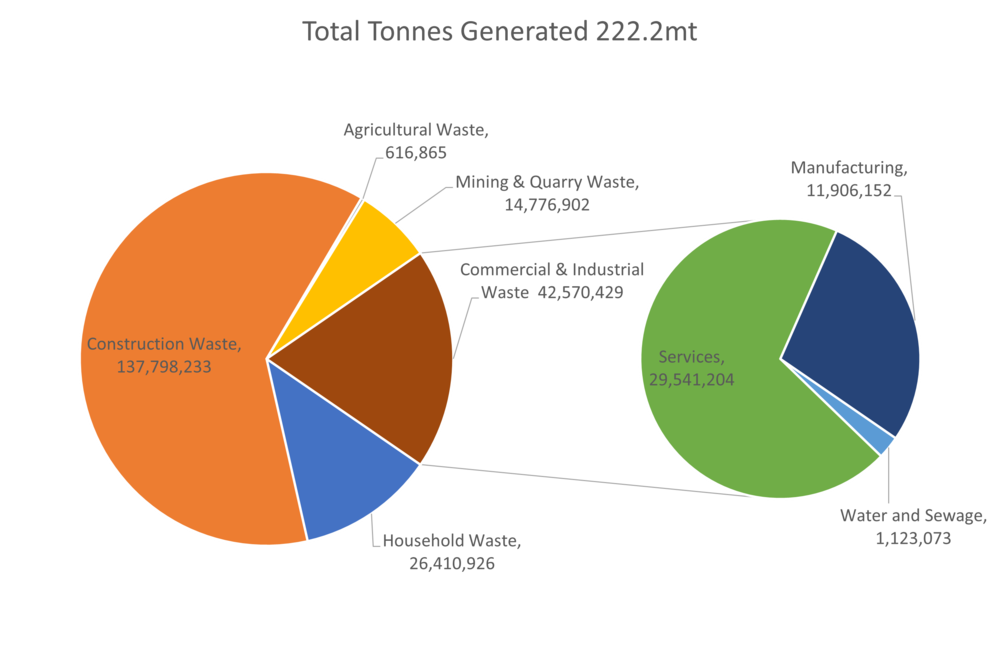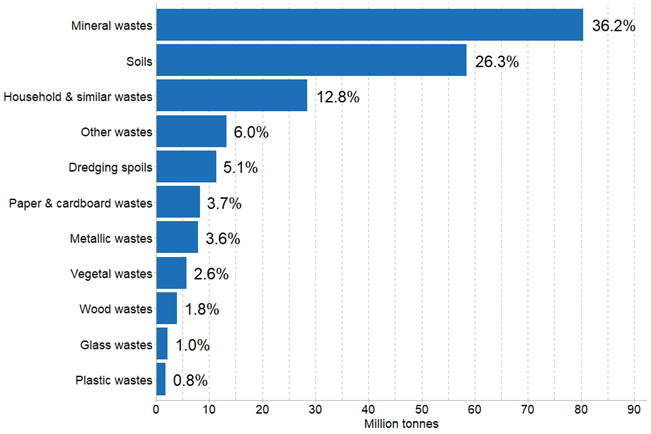UK Waste Tonnage: Difference between revisions
(→Headline Figures: format change) |
(updated wit 2021 data and link) |
||
| (10 intermediate revisions by the same user not shown) | |||
| Line 1: | Line 1: | ||
[[Category:Tonnage & Waste Types]] | [[Category:Tonnage & Waste Types]][[Category:Targets & Metrics]] | ||
The total waste arisings per year for the UK reported by [[DEFRA]] in | The total waste arisings per year for the UK reported by [[DEFRA]] in May 2022 was for core data reported for 2018 <ref>[https://www.gov.uk/government/statistics/uk-waste-data UK Statistics on Waste May 2022 update]</ref> and was '''222.2 million tonnes''', with 84% of that tonnage arising from England. This is an increase of 1.8% on the figures reported for 2016. | ||
== Headline Figures == | == Headline Figures == | ||
The macro-level data reported in | The macro-level data reported in 2020 by [[DEFRA]] for tonnage arisings is summarised in the figure below (produced by [[Monksleigh]] from the raw [[DEFRA]] data), with a total of 222.2 million tonnes of waste arising in the UK (with England responsible for 84% of the total): | ||
[[File:UK Macro Tonnage Graphic.png|1000px|centre|UK Waste Tonnage Summary]] | |||
[[ | Figures from 2016 (the previous base year) and those reported earlier in 2020 reflected adjustments by [[DEFRA]] to report dry weights associated with tonnage arisings of Sludges. The summary text in the July 2020 [[DEFRA]] report stated: | ||
* around 80.4 million tonnes was mineral Waste and 58.5 million tonnes was soils in 2018 (primarily from construction), the two largest waste categories in the UK (63% of the total) | |||
* around 26.4 million tonnes was waste arisings from households in 2019 (22.1 million tonnes was from England equivalent to 83% of the total and virtually the unchanged between 2018 and 2019) | |||
* around 43.9 million tonnes was [[Commercial and Industrial Waste]] or [[C&I Waste]] in 2018 with unchanged estimates for England for 2019 (around 37.2 million tonnes or 85% was generated in England). | |||
'''Extract from DEFRA data digest : Waste Generation by Waste Material, UK, 2018''' | |||
[[File:Waste Mix 2018.png|700px|center|Waste generation by material - UK 2018]] | |||
== Key Destination Information == | == Key Destination Information == | ||
* [[Recycling]] and [[Recovery]] : around | * [[Recycling]] and [[Recovery]] : around 108.4 million tonnes (50.4%) was recycled or recovered in 2018 (55% of which was mineral wastes and 12% soils) | ||
* [[Energy Recovery Facility|Energy Recovery]] : around | * [[Energy Recovery Facility|Energy Recovery]] : around 8.5 million tonnes (vs a capacity of 11.4 million tonnes) was used for energy recovery based on 2018 data (classified by [[DEFRA]] as those sites which have [[R1]] status, those without are reported as [[Incineration]]) | ||
* [[Landfill]] : around | * [[Landfill]] : around 50.8 million tonnes (23.6%) of waste went to landfill in 2018 | ||
* [[Waste Derived Fuel]] Export : around 3.2 million tonnes of [[RDF]] or [[SRF]] was sent outside of the UK for energy recovery (the majority to the Netherlands, Germany and Sweden) | * [[Waste Derived Fuel]] Export : not reported, but previously reported at around 3.2 million tonnes of [[RDF]] or [[SRF]] was sent outside of the UK for energy recovery (the majority to the Netherlands, Germany and Sweden) | ||
== Performance against Key Targets == | == Performance against Key Targets == | ||
* The UK recycling rate for households was 45.0% <ref>with | * The UK recycling rate for waste from households was 46.6% in 2019 vs 45.0% in 2018<ref>with variations in England performance primarily linked to a variation in green waste with changes in plant growth in the year, Northern Ireland improvement due to the introduction of food waste collections, and Wales the improvement in reporting of wood waste destinations has led to a reduction in performance reported from 2018. Figures include the metal from [[IBA]]</ref> against an EU target of 50% by 2020. The 2020 target was missed by the UK and the 2021 performance<ref>https://www.gov.uk/government/statistics/uk-waste-data/uk-statistics-on-waste#impact-of-coronavirus-covid-19</ref> did not change dramatically on the 2020 figures: | ||
{| class="wikitable" | {| class="wikitable" | ||
|- | |- | ||
! Country !! 2018 !! | ! Country !! 2017 !! 2018 !!2019 !!2020 !!2021 | ||
|- | |- | ||
| England || 44.7% || | | England || 45.2% || 44.7% ||45.5%||44.0%||44.1% | ||
|- | |- | ||
| Northern Ireland || 47.7% || | | Northern Ireland || 46.3%||47.7% ||50.6%||49.1%||48.4% | ||
|- | |- | ||
| Scotland || 42.8% || 43.5% | | Scotland || 43.5%||42.8%||43.5%||41.0%||41.7% | ||
|- | |- | ||
| Wales || 54.1% || | | Wales || 55.2%||54.1%||56.4%||56.5%||56.7% | ||
|- | |- | ||
| UK Total || 45.0% || | | UK Total || 45.5%||45.0%||46.0%||44.4%||44.6% | ||
|} | |} | ||
* The UK C&D | * The UK C&D recovery rate was 92.3% in 2018 (against an EU target of 70% by 2020) equivalent to recovering around around 62.6 million tonnes of the 67.8 million tonnes classified as non-hazardous C&D wastes. The recovery rates for 2019 and 2020 were 93.6% and 93.2% respectively. | ||
* The UK [[BMW]] to [[Landfill]] | * The UK [[BMW]] to [[Landfill]] has fallen from around 6.6 million tonnes in 2019 to 6.1 million tonnes in 2020. An increase to 6.8 million tonnes occurred in 2021. | ||
* The UK packaging waste either recycled or recovered was | * The UK packaging waste either recycled or recovered was confirmed at 63.2% in 2021, similar to 2020. | ||
==References== | ==References== | ||
<references /> | <references /> | ||
Latest revision as of 05:43, 28 June 2023
The total waste arisings per year for the UK reported by DEFRA in May 2022 was for core data reported for 2018 [1] and was 222.2 million tonnes, with 84% of that tonnage arising from England. This is an increase of 1.8% on the figures reported for 2016.
Headline Figures
The macro-level data reported in 2020 by DEFRA for tonnage arisings is summarised in the figure below (produced by Monksleigh from the raw DEFRA data), with a total of 222.2 million tonnes of waste arising in the UK (with England responsible for 84% of the total):

Figures from 2016 (the previous base year) and those reported earlier in 2020 reflected adjustments by DEFRA to report dry weights associated with tonnage arisings of Sludges. The summary text in the July 2020 DEFRA report stated:
- around 80.4 million tonnes was mineral Waste and 58.5 million tonnes was soils in 2018 (primarily from construction), the two largest waste categories in the UK (63% of the total)
- around 26.4 million tonnes was waste arisings from households in 2019 (22.1 million tonnes was from England equivalent to 83% of the total and virtually the unchanged between 2018 and 2019)
- around 43.9 million tonnes was Commercial and Industrial Waste or C&I Waste in 2018 with unchanged estimates for England for 2019 (around 37.2 million tonnes or 85% was generated in England).
Extract from DEFRA data digest : Waste Generation by Waste Material, UK, 2018

Key Destination Information
- Recycling and Recovery : around 108.4 million tonnes (50.4%) was recycled or recovered in 2018 (55% of which was mineral wastes and 12% soils)
- Energy Recovery : around 8.5 million tonnes (vs a capacity of 11.4 million tonnes) was used for energy recovery based on 2018 data (classified by DEFRA as those sites which have R1 status, those without are reported as Incineration)
- Landfill : around 50.8 million tonnes (23.6%) of waste went to landfill in 2018
- Waste Derived Fuel Export : not reported, but previously reported at around 3.2 million tonnes of RDF or SRF was sent outside of the UK for energy recovery (the majority to the Netherlands, Germany and Sweden)
Performance against Key Targets
- The UK recycling rate for waste from households was 46.6% in 2019 vs 45.0% in 2018[2] against an EU target of 50% by 2020. The 2020 target was missed by the UK and the 2021 performance[3] did not change dramatically on the 2020 figures:
| Country | 2017 | 2018 | 2019 | 2020 | 2021 |
|---|---|---|---|---|---|
| England | 45.2% | 44.7% | 45.5% | 44.0% | 44.1% |
| Northern Ireland | 46.3% | 47.7% | 50.6% | 49.1% | 48.4% |
| Scotland | 43.5% | 42.8% | 43.5% | 41.0% | 41.7% |
| Wales | 55.2% | 54.1% | 56.4% | 56.5% | 56.7% |
| UK Total | 45.5% | 45.0% | 46.0% | 44.4% | 44.6% |
- The UK C&D recovery rate was 92.3% in 2018 (against an EU target of 70% by 2020) equivalent to recovering around around 62.6 million tonnes of the 67.8 million tonnes classified as non-hazardous C&D wastes. The recovery rates for 2019 and 2020 were 93.6% and 93.2% respectively.
- The UK BMW to Landfill has fallen from around 6.6 million tonnes in 2019 to 6.1 million tonnes in 2020. An increase to 6.8 million tonnes occurred in 2021.
- The UK packaging waste either recycled or recovered was confirmed at 63.2% in 2021, similar to 2020.
References
- ↑ UK Statistics on Waste May 2022 update
- ↑ with variations in England performance primarily linked to a variation in green waste with changes in plant growth in the year, Northern Ireland improvement due to the introduction of food waste collections, and Wales the improvement in reporting of wood waste destinations has led to a reduction in performance reported from 2018. Figures include the metal from IBA
- ↑ https://www.gov.uk/government/statistics/uk-waste-data/uk-statistics-on-waste#impact-of-coronavirus-covid-19
